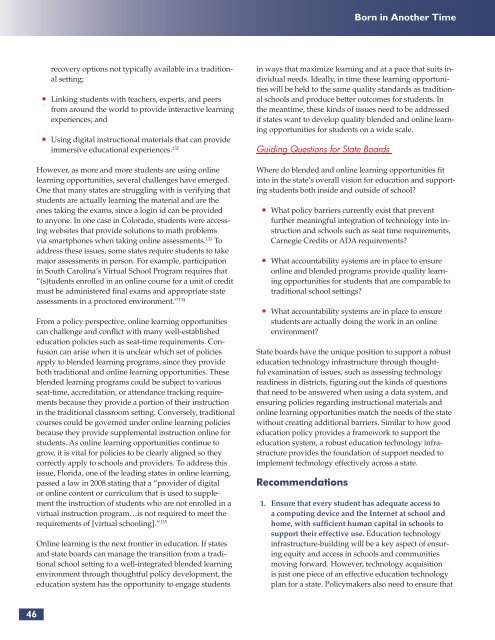You also want an ePaper? Increase the reach of your titles
YUMPU automatically turns print PDFs into web optimized ePapers that Google loves.
46<br />
recovery options not typically available in a traditional<br />
setting;<br />
Linking students with teachers, experts, and peers<br />
from around the world to provide interactive learning<br />
experiences; and<br />
Using digital instructional materials that can provide<br />
immersive educational experiences. 132<br />
However, as more and more students are using online<br />
learning opportunities, several challenges have emerged.<br />
One that many states are struggling with is verifying that<br />
students are actually learning the material and are the<br />
ones taking the exams, since a login id can be provided<br />
to anyone. In one case in Colorado, students were accessing<br />
websites that provide solutions to math problems<br />
via smartphones when taking online assessments. 133 To<br />
address these issues, some states require students to take<br />
major assessments in person. For example, participation<br />
in South Carolina’s Virtual School Program requires that<br />
“(s)tudents enrolled in an online course for a unit of credit<br />
must be administered fi nal exams and appropriate state<br />
assessments in a proctored environment.” 134<br />
From a policy perspective, online learning opportunities<br />
can challenge and confl ict with many well-established<br />
education policies such as seat-time requirements. Confusion<br />
can arise when it is unclear which set of policies<br />
apply to blended learning programs, since they provide<br />
both traditional and online learning opportunities. These<br />
blended learning programs could be subject to various<br />
seat-time, accreditation, or attendance tracking requirements<br />
because they provide a portion of their instruction<br />
in the traditional classroom setting. Conversely, traditional<br />
courses could be governed under online learning policies<br />
because they provide supplemental instruction online for<br />
students. As online learning opportunities continue to<br />
grow, it is vital for policies to be clearly aligned so they<br />
correctly apply to schools and providers. To address this<br />
issue, Florida, one of the leading states in online learning,<br />
passed a law in 2008 stating that a “provider of digital<br />
or online content or curriculum that is used to supplement<br />
the instruction of students who are not enrolled in a<br />
virtual instruction program…is not required to meet the<br />
requirements of [virtual schooling].” 135<br />
Online learning is the next frontier in education. If states<br />
and state boards can manage the transition from a traditional<br />
school setting to a well-integrated blended learning<br />
environment through thoughtful policy development, the<br />
education system has the opportunity to engage students<br />
Born in Another Time<br />
in ways that maximize learning and at a pace that suits individual<br />
needs. Ideally, in time these learning opportunities<br />
will be held to the same quality standards as traditional<br />
schools and produce better outcomes for students. In<br />
the meantime, these kinds of issues need to be addressed<br />
if states want to develop quality blended and online learning<br />
opportunities for students on a wide scale.<br />
Guiding Questions for State Boards<br />
Where do blended and online learning opportunities fi t<br />
into in the state’s overall vision for education and supporting<br />
students both inside and outside of school?<br />
What policy barriers currently exist that prevent<br />
further meaningful integration of technology into instruction<br />
and schools such as seat time requirements,<br />
Carnegie Credits or ADA requirements?<br />
What accountability systems are in place to ensure<br />
online and blended programs provide quality learning<br />
opportunities for students that are comparable to<br />
traditional school settings?<br />
What accountability systems are in place to ensure<br />
students are actually doing the work in an online<br />
environment?<br />
State boards have the unique position to support a robust<br />
education technology infrastructure through thoughtful<br />
examination of issues, such as assessing technology<br />
readiness in districts, fi guring out the kinds of questions<br />
that need to be answered when using a data system, and<br />
ensuring policies regarding instructional materials and<br />
online learning opportunities match the needs of the state<br />
without creating additional barriers. Similar to how good<br />
education policy provides a framework to support the<br />
education system, a robust education technology infrastructure<br />
provides the foundation of support needed to<br />
implement technology effectively across a state.<br />
Recommendations<br />
1. Ensure that every student has adequate access to<br />
a computing device and the Internet at school and<br />
home, with suffi cient human capital in schools to<br />
support their effective use. Education technology<br />
infrastructure-building will be a key aspect of ensuring<br />
equity and access in schools and communities<br />
moving forward. However, technology acquisition<br />
is just one piece of an effective education technology<br />
plan for a state. Policymakers also need to ensure that


